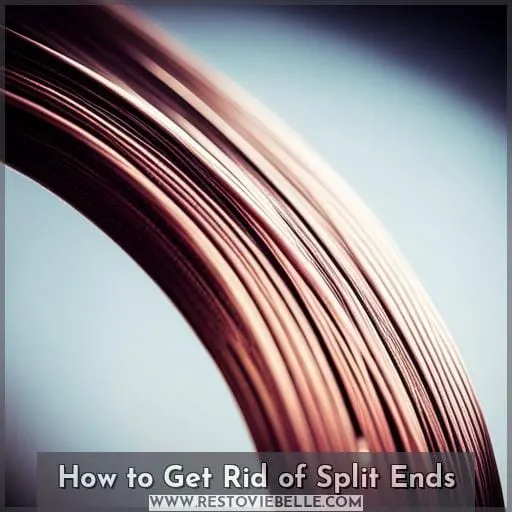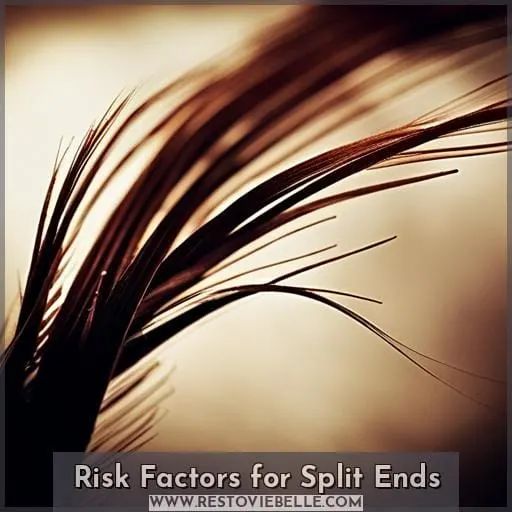This site is supported by our readers. We may earn a commission, at no cost to you, if you purchase through links.
 Discover the causes and prevention of split ends, so you can keep your hair healthy and vibrant.
Discover the causes and prevention of split ends, so you can keep your hair healthy and vibrant.
When your hair becomes dry, brittle, and frayed at the ends, it’s time to take action. Exposure to extreme weather conditions or using harsh hair care techniques can contribute to split ends. But don’t worry – there are steps you can take to fix this issue! From cutting off those pesky splits to using nourishing masks and conditioners, we’ll show you how to combat split ends for good.
Table Of Contents
Key Takeaways
- Exposure to environmental extremes can cause split ends.
- Damaging hair care techniques, such as frequent blow-drying and straightening, contribute to split ends.
- Overuse of chemical hair products can lead to split ends.
- Gentle hair care practices, regular maintenance, and careful product selection can help prevent and treat split ends.
Causes of Split Ends
You likely wonder what leads to the annoying split ends in your hair. Main culprits include:
- Exposure to extreme hot or cold weather.
- Frequent use of damaging hair care techniques like blowdrying and straightening.
- Overuse of chemical hair products.
Understanding what causes split ends empowers you to make changes to prevent further damage.
Exposure to Extreme Weather Conditions
Exposure to extreme weather dries out your hair and weakens it, leading to split ends.
- Heat from the sun can damage hair protein bonds.
- Cold, dry air strips moisture from hair.
- Wind pulls on hair, causing mechanical damage.
Frequent exposure leaves hair fragile and prone to splitting on ends. Guard strands with protective styles, hats, conditioners.
Hair Care Techniques
However, are hair care techniques like blow drying, straightening, and curling also causing your split ends?
When you’re frequently manipulating your hair with heat tools and tension, you’re weakening the bonds in each strand leading to splits.
Avoid over-brushing, use gentle shampoo, avoid heat styling, trim regularly, use leave-in conditioners, hair masks, hair conditioners for hair repair.
Limit hair styling and hair products that damage hair.
Chemical Hair Products
As you’re using hair care products, the chemicals in them can also contribute to split ends. They can damage and dry out your hair over time, making it more prone to splitting.
You’ll want to be mindful of the types and amounts of products you use. Look for safe chemical hair products that are sulfate-free, silicone-free, and paraben-free. Opting for natural chemical hair products can help prevent further damage and promote healthier-looking strands.
How to Get Rid of Split Ends
To get rid of split ends, there are several methods you can try.
The most effective way is to simply cut them off, removing the damaged portion of the hair.
However, if you’re looking for alternative options, some people have had success with candle cutting (although caution is advised as it may damage hair follicles).
Additionally, using hair masks and leave-in conditioners can help nourish and repair split ends.
Another option is to make your own conditioner using natural ingredients known for their moisturizing properties.
Cut Them Off
Since regularly trimming split ends is the only way to truly get rid of them, you’ll want to schedule regular haircuts about every 6-8 weeks to snip off any splits that have formed.
When it comes time to cut your hair, make sure you focus on cutting the ends first. Trim off any split or damaged sections before moving on to the rest of your hair. This will help prevent further splitting and keep your locks healthy and strong.
Try Candle Cutting (with Caution)
Your split ends may be slightly trimmed through carefully attempting candle cutting, though this risks damaging hair follicles.
Candle cutting involves using a lit candle to burn off the split ends of your hair. However, it’s important to proceed with caution as this method can cause heat damage and further exacerbate split ends if not done properly.
- Use a small section of hair at a time
- Keep the flame away from your scalp
- Move the flame quickly along the length of your hair
- Avoid touching or applying pressure on the burning end
- Follow up with a nourishing hair mask for repair and hydration
Use Hair Masks and Leave-in Conditioners
Having tried candle cutting, use hair masks and leave-in conditioners regularly to deeply hydrate damaged strands.
These nourishing treatments moisturize, strengthen, and repair hair.
Apply a hair mask 1-2 times per week, focusing on ends.
Leave-in conditioners can be used daily for lightweight conditioning.
Reap benefits like softer, shinier, more manageable hair.
Target split ends with these affordable at-home treatments.
Make Your Own Conditioner
To further combat split ends, try making your own conditioner using nourishing ingredients.
Making your own conditioner allows you to control what goes into it and avoid harmful chemicals that can contribute to hair damage.
Some beneficial ingredients for homemade conditioners include coconut oil, honey, avocado, and aloe vera.
You can experiment with different combinations of these ingredients to find the best formula for your hair type.
Store your homemade conditioner in a clean container in a cool place to maintain its freshness and effectiveness.
Preventing Split Ends
Limit hairstyles causing damage like tight ponies.
Use soft scrunchies over metal clips and rubber bands.
Prevention starts with being gentle day-to-day.
Limit Damaging Hairstyles
If you’re trying to prevent split ends, limit how often you wear hairstyles that can cause damage to your hair.
To protect your strands from splitting, avoid tight braids and ponytails that pull on the hair.
Skip the high buns and opt for looser styles instead.
Give your hair a break from weaves and extensions as well.
By choosing gentle hairstyles, you can reduce the risk of developing split ends and keep your locks healthy.
Use Softer Hair Ties
You’ll often prevent split ends by using softer hair ties instead of ones that tug and pull.
Avoid elastic hair ties, as they can cause breakage and damage to your delicate strands.
Opt for fabric or silk scrunchies that are gentler on the hair.
Additionally, try to avoid tight hairstyles like ponytails and braids, which can create tension and lead to split ends.
Consider using satin scarves or wearing silk pillowcases at night to minimize friction while you sleep.
Risk Factors for Split Ends
If you have afro-textured hair, you may be at a higher risk for split ends.
This is because the natural curl pattern of afro-textured hair makes it more prone to tangling and breakage.
Additionally, women going through menopause may also experience an increased risk of split ends due to hormonal changes that can affect the health and strength of their hair strands.
Afro-textured Hair
Your afro-textured hair is more prone to developing split ends due to its naturally drier and more fragile 4c hair texture. This hair type tends to have higher porosity and lower density, allowing moisture to escape while providing less protection.
Regular deep conditioning and protective styles that avoid manipulation can help combat splits.
Using gentle, moisturizing products for natural hair is key, as is maintaining trim schedules to nip damage before it travels up the strand.
With some thoughtful care, your beautiful coils can thrive split-free.
Menopause
Going through menopause, you’re at an increased risk for split ends as hormonal changes can lead to drier, more fragile hair. These hormone changes include decreased estrogen levels which can affect hair growth and result in thinning hair.
Additionally, scalp health may be compromised during menopause leading to increased hair shedding.
It’s important to take extra care of your hair during this time by implementing a proper hair care routine and nourishing your strands with hydrating products for optimal hair regrowth.
General Tips for Healthy Hair
To maintain healthy hair and prevent split ends, there are some general tips you should follow.
Prevention is key, so try to limit your use of styling tools that can cause damage.
Additionally, make sure to keep your hair well-conditioned by using nourishing products and avoiding harsh chemicals.
By incorporating these practices into your hair care routine, you can promote the overall health of your hair and minimize the risk of developing split ends.
Prevention is Key
Preventing split ends requires limiting your use of damaging styling tools and keeping your hair properly conditioned.
To protect against damage, avoid rubbing wet hair with a towel and instead blot it dry gently.
Use a wide-tooth comb to detangle wet or dry hair without causing breakage.
Moisturize regularly by applying a weekly hair mask and using heat protectant products when styling with heated appliances.
Protect your strands at night by sleeping on silk or satin pillowcases or wearing silk scarves to reduce friction.
Use Styling Tools Less Often
Although you’re used to frequently using hot styling tools, limiting how often you expose your hair to high heat can help prevent split ends.
- Letting your hair air dry allows the hair cuticle to close and prevents damage.
- Use heat protecting sprays or serums before using any hot tool.
- Sleep on a silk pillowcase to avoid friction.
- Avoid chemical treatments that strip moisture from your hair.
- Nourish hair with weekly deep conditioning masks.
Keep Hair Well-conditioned
When it comes to keeping your hair healthy, you’d do well to keep it conditioned regularly.
Deep conditioning is an effective way to moisturize and repair damaged hair, preventing split ends.
You can also try DIY hair masks using nourishing ingredients for added hydration.
Don’t fall for split end myths – the only solution is regular trimming.
Incorporate proper hydration techniques into your routine and enjoy healthier, stronger hair.
Frequently Asked Questions (FAQs)
Can split ends be repaired without cutting the hair?
Unfortunately, no. The only way to truly repair split ends is to have them trimmed off. Applying conditioners and hair masks can temporarily mend the split and make hair appear healthier, but won’t structurally fix the damage.
Can split ends be caused by genetics?
Yes, genetics can play a role in causing split ends.
Your hair’s natural texture and thickness, which are determined genetically, affect its susceptibility to splitting.
Those with very curly or thick hair may be more prone, while those with straighter, thinner hair may have less issues with splitting.
Using gentle hair care methods can help minimize split ends regardless of one’s genetic predisposition.
Is it true that split ends can cause hair to stop growing?
Yes, it’s true split ends can prevent hair growth.
As the splits travel up strands, hair becomes increasingly fragile until strands snap off entirely.
Regular trims are essential to nip damage in the bud, maintaining healthy lengths and continued growth.
Conditioning treatments also help minimize splits by strengthening and protecting hair shafts.
Are split ends more common in certain hair types?
Split ends are a universal hair issue, but they can be more prevalent in certain hair types.
Afro-textured hair and women going through menopause may be at higher risk.
Proper care and prevention techniques can help all hair types avoid split ends.
Can split ends be prevented by using specific hair products?
To prevent split ends, use nourishing hair products that provide hydration and protection.
Look for products with ingredients like argan oil or keratin.
Additionally, using a heat protectant before styling can help minimize damage to your hair.
Conclusion
To keep your hair healthy and vibrant, it’s crucial to understand the causes and prevention of split ends.
Exposure to extreme weather conditions, harsh hair care techniques, and chemical hair products can all contribute to split ends.
[Keypoints]To get rid of split ends, consider:
- Cutting them off
- Using nourishing hair masks and leave-in conditioners
- Making your own conditioner
Preventing split ends involves:
- Limiting damaging hairstyles
- Using softer hair ties











